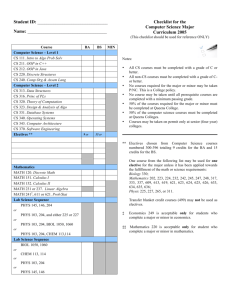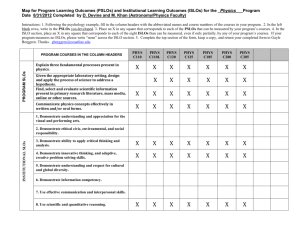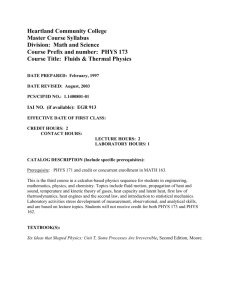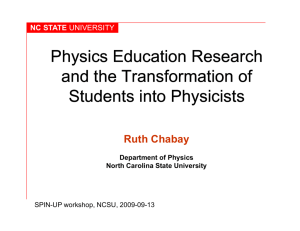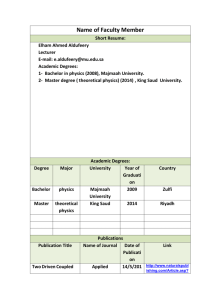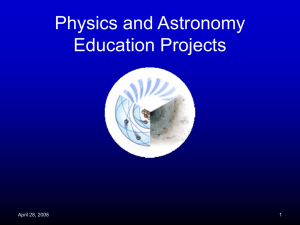Slides
advertisement
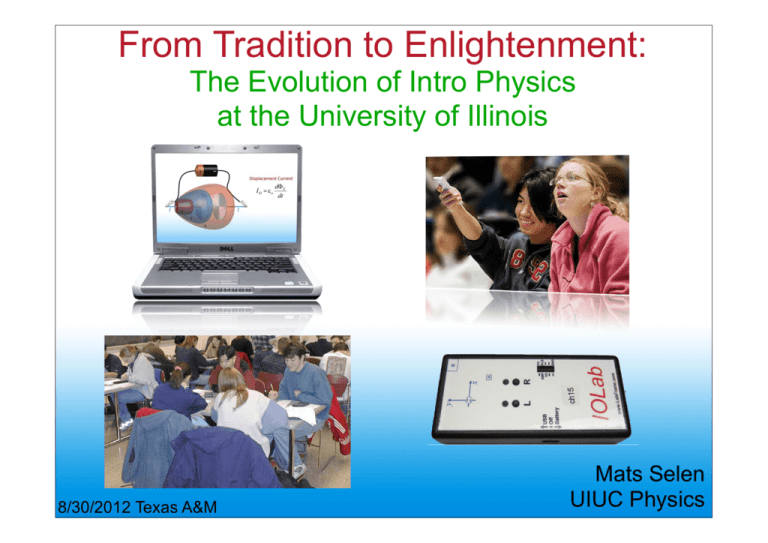
From Tradition to Enlightenment: The Evolution of Intro Physics at the University of Illinois 8/30/2012 Texas A&M Mats Selen UIUC Physics Talk Outline • Ini%al Illinois course revisions (1996-­‐2001) – Why this was a big deal – Why everyone should do it • Two cool projects enabled by this – Prelectures (2005 -­‐ ...) – Interac%ve Online Labs (brand new) 2 How I know Jairo & George If you are a young scientist you need to check out their Cottrell Scholars program: http://www.rescorp.org 3 Faculty: Gary Gladding Jose Mestre Mats Selen Tim Stelzer Affiliates: Michel Herquet Morten Lundsgaard Michael Scott Grad Students: Zhongzhou Chen Witat Sara Rose Katie Crimmins Fakcharoenphol Noah Schroeder Intro Physics at Illinois Enrollment (as of yesterday) PHYS 100: 536 PHYS 101: 516 PHYS 102: 278 PHYS 110: 158 PHYS 140: 196 PHYS 150: 56 PHYS 211: 966 PHYS 212: 1203 PHYS 213: 553 PHYS 214: 600 Total: 5062 The spring is bigger Parallel Parking an Aircraft Carrier Forum on Education of the Am. Phys. Soc, Summer 1997 Intro Calculus Based Physics at Illinois Physics 211 (4 hrs, mechanics) Physics 212 (4 hrs, E&M) Physics 213/214 (2+2 hrs, SM, QM) About 4400 students/year in these 2 classes Mostly Engineering & Physics majors Pretty Typical Class Structure: Lecture, Lab, Discussion… Big changes in these courses happened over 15 years ago… 1300 in 211 960 in 211 940 in 212 1200 in 212 Fa g ll in r Sp How it worked in 1993: (sometimes good, often terrible) • Tradi%on, Tradi%on, Tradi%on – Lecturer “owns” the course and is free to “reinvent the flat %re” every semester. – Discussion TAs preQy much on their own. – Labs intellectually disconnected from rest of course. • Results: Nobody is happy !! – Lecturer dislikes it since it’s a monster teaching assignment. – Students hate it because they see the lecturer dislikes it, (and its oYen not very good) – Engineering dislikes it because the product is inconsistent (and because their students hate it). How we* changed it around 1996: – Permanent Infrastructure * Lead by Gary Gladding & David Campbell • Course material is basically fixed • Recycled & tuned from semester to semester. • People don’t need to re-­‐invent the whole stew, but can focus on the spices! – Typically 3-­‐4 faculty share the load: • Lecturer(s) • Discussion Director • Lab Director – Course administra%on is shared responsibility: • Directors meet weekly with their TA’s. • Overall co-­‐ordina%on is very %ght. • Everybody works on crea%ng & giving exams. Advantages of this approach: – Exis%ng infrastructure lowers the bar for par%cipa%on. • This is now seen as a reasonable teaching load. • Most of our new junior faculty start teaching in these courses (i.e. not a heavy assignment). •This approach enables innova%on – Pain & Gain are shared • No burnout & No heroes. • Makes it possible to keep quality high and material consistent even though instructors are changing. •This approach is sustainable. Summary of the iniKal renovaKon: OLD (Spring 1995) NEW (Spring 2001) Lectures Blackboard, Transparencies & Demos 75 min, PowerPoint, Demos, Peer InstrucKon, Just in Time Teaching Discussion TA’s worked problems on the board CollaboraKve Learning, materials based on PER Labs Intellectually disconnected, focus on measurement Predict-­‐Observe-­‐Explain, Focus on concepts Homework End of Chapter problems, (or NovaNet) Web Based (TYCHO), InteracKve Examples Exams MulK part problems, free response, hand graded MulKple Choice, Created by faculty team TA Instruc%on None OrientaKon & training, Mentor TA observaKon Overview: Discussion SecKons (2 hrs/week) TA will guide, not lecture A Question!! No HW problems here Key Idea: Collabora%ve Learning Students work in groups of 4 on problems prepared by the senior staff. TAs act as facilitators, not lecturers. TA prepara%on very important (extensive training program). Orienta%on, Weekly Mee%ngs, Mentor TAs, Observa%on Content of prepared materials very important Example discussion problem Two astronauts, each having a mass 75 kg, are connected by a light rope 10 meters long. They are isolated in space, and are ini%ally revolving around their common center of mass once every 6 seconds. They now pull in on the rope, halving the distance between them. How much work is done by the astronauts as they shorten the rope? Overview: Lab SecKons (2 hrs most weeks) PREDICT OBSERVE EXPLAIN Engage the students in the learning process and promote mastery of concepts by manipula%on of experimental apparatus. Prelab assignments; Lab reports finished within class period. (and much easier to grade than the old style) Effect of iniKal structural changes: AIer (2001) Before (1995) bad good Before (Spring 95) Total Physics TAs = 77 # “Excellent” = 15 19 ± 5 % good bad AIer (Spring 01) Total Physics TAs = 75 # “Excellent” = 58 77 ± 6 % The Challenge (part 1) Faculty Buy-­‐in “The Course” is no-longer just “My Lectures” Question: How do lectures fit right now? Time (Students) Time (Professor) 70% 15% 15% Lecture Discussion Lab Homework Exams & Quizzes 15% 18% 35% 16% 16% 15 The Challenge (part 1) Faculty Buy-­‐in “The Course” is no-longer just “My Lectures” Question: How do lectures fit right now? Fraction of Grade 5% 10% 15% 60% 10% Lecture Discussion Lab Homework Exams 16 The Challenge (part 1) Need a paradigm shift: Lab Homework & exams Lecture Discussion 17 Time to do other things. Paradigm shift Reluctant Prof: Gary Gladding: It won’t be my own course anymore! This is good. You won’t have to do it all by yourself. But I like to do stuff my way You can still personalize it, you just can’t wreck it. Whats in it for me Time to do other things. Infrastructure is the key ! 18 The Challenge (part 2) Sustainability: “People who create reform are usually not the same people who enjoy making the trains run on time” Again - Infrastructure is the key ! (i.e. Departmental commitment) Cost per student is no higher than the old approach (and it scales better). 19 Effect of iniKal structural changes: AIer (2001) Before (1995) bad good Before (Spring 95) Total Physics TAs = 77 # “Excellent” = 15 19 ± 5 % good bad AIer (Spring 01) Total Physics TAs = 75 # “Excellent” = 58 77 ± 6 % IncenKve for further innovaKon... What’s the next big problem? Students are not reading the text and aren’t prepared for class Lecturer has to assume that students know nothing coming into the classroom. We spend (waste) a lot of time going over very basic material. Difficult material is often rushed and student only see it once. New Approach to Lecture (2008 - ...) Pre Lectures Checkpoints (JiTT) Peer Instruction (old: 75 min, new: 50 min) Pre Lectures Viewed prior to each lecture (usually the night before) Students do this instead of reading a textbook Introduces all concepts for the coming lecture and provides feedback to both students and professor Our students watch the prelectures Textbook Prelectures Next: Checkpoints (aka Just in Time Teaching) Online knowledge check of prelecture concepts Completed after Prelecture but before Lecture. Increases student buy-in for upcoming lecture Feedback to professor helps lecture prep. (we’ve been doing this for 15 years) Checkpoint Example Grade for participation, not for correctness Useful information… wrong right Student explanations for “it spills over”… CheckPoint When the ice melts, the level of the water in the glass will: A) Go up, causing the water to spill out of the glass. B) Go down. C) Stay right at the brim. A) The water level will rise. I learned that from Al Gore in "An Inconvenient Truth" B) volume of ice is greater than volume of water In Class C) The melted water has exactly the same mass as the ice cube, and the volume of water displaced is equal to the mass of the ice cube. “The ice melting in cup of water question confuses me. So if the water level doesn't change, why worry about global warming?” From subsequent lecture 29 Lectures = Peer Instruction • Lectures are very interactive – We know students are prepared (Prelectures) – We know their misconceptions (Checkpoints) • Typically ask 6-10 clicker questions per lecture • Valuable feedback for both teacher and students 15 years ago, class questions made me realize my lectures were not as great as I though they were. That’s what started all this for me. How does all this impact our students? Am. J. Phys. 78, 755-759, 2010 Phys. Rev. ST Phys. Educ. Res. 6, 1-5, 2010 Checkpoint Study A measurement of students concept knowledge Spring 06 56% Spring 07 57% Checkpoint Study Overall Results Checkpoint Study Overall Results Viewers vs. Non-Viewers Non-Viewers Viewers Audio narration time of Prelecture 35 Viewers vs. Non-Viewers 36 Checkpoint Study Significant improvement seen for all students Changes Made Learning Easier! Before After Before After Before After What’s Next? Present Status Lecture: (50 min) JiTT & Peer Instruc%on, smartPhysics (good) Discussion: Peer instruc%on, trained & mentored TA’s (good) Homework: Online, including Interac%ve Examples (good) Labs: Group work (tradi%onal) (not so good) Exams: Mul%ple Choice (good) Hmmm… Labs are typically “underappreciated” • Students don’t rate them highly – Hard to see connec%on to rest of class – Group work leaves some people inac%ve – Focus is to get finished & leave • OYen don’t quite “fit in” with the course – Timing rarely op%mum • They are expensive to run – TA’s, equipment, space… Interactive Online Labs Hands-on activities delivered & graded online. The Big Idea: Each student has their own device (buy cheap). They are guided through each ac%vity by interac%ve soYware. Timing of ac%vi%es driven by pedagogy, not space/budget. Not just a simulation… Lets look inside • MSP430 processor – 8 bit RISC, 12 A/D channels, 8 I/O, – CC2500 2.4GHz wireless transceiver sends data to PC (similar unit plugged into PC) • Peripherals – 3D accelerometer – 3D Hall probe – 40kHz transducer (range) – A/C coupled amp input (x40,000) – V1, V2 “scope” inputs – Pulser output Enabled by cheap consumer electronics Next version smaller & more capable (force probe, gyro, etc… more later) Demo – friction, SHM We built 60 prototypes What we have tested so far: (using prototype hardware & soYware) • Mechanics (using accelerometer): – KinemaKcs – RelaKve MoKon – FricKon – Free-­‐fall & air resistance – Pendulum – Centripetal acceleraKon • E&M (using voltage inputs) – MagneKc inducKon & Faraday’s law Modern Physics (using RF signal) – ProperKes of microwaves (2.4GHz) – ReflecKon of electromagneKc waves by a metal surface – Speed of light (~2% accuracy!) – OpKcal density and index of refracKon • Circuits (using voltage In/Out) – InvesKgate Ohms & Kirchhoff's laws – InvesKgate RC circuit, exponenKal decay & measure Kme constant E&M (using Hall sensors) – Earth magneKc field – Field from current carrying wire (strength ~ 1/r) – Field from a dipole (strength ~ 1/r3) • • • Other – Wireless heart monitor (ECG) – VibraKonal Spectroscopy – Temperature monitoring It really works (tested by > 500 UofI students) History & Plan: • 2010: Created prototype hardware & firmware & soYware. Preliminary tes%ng with volunteer students. • Jan/2011: Wrote NSF/TUES proposal to study IOLab pedagogy. – Funded for 4 years (Stelzer & Selen). • Spring/2011: Developed IOLab PC applica%on. – Applica%on walks students through hands-­‐on ac%vi%es • Fall/2011: Tested in Physics 100 (500 students) – Used IOLab in discussion to explore kinema%cs & rela%ve mo%on. • March/2012: Tested in Physics 212 (30 students) – Used IOLab to independently explore magnets, coils & Faraday’s Law. • Summer/2012: Version 2 prototypes • Fall/2012: Develop V2 soYware. Develop content. A Peek at Version 2 Hardware • Features – 3D accelerometer – 3D magnetometer (.01 BE) – – – – – – – – – – – Force probe (± 10 N) Ultrasound ranger (dual mode). 3D gyro (gives orienta%on) Posi%on encoder wheel for x, v, a rela%ve to desk 1 DC & 3 AC coupled high gain differen%al amplifiers w/ external inputs Light intensity sensor Atmospheric pressure sensor Temperature sensor Buzzer & microphone Much higher sample rate & data transfer rate Extensive expansion port including ADC in, PIO & DAC out, I2C, SPI Demo ! Amusing Distraction #1: Cheap ECG Amusing Distraction #2: Diagnostic Spectroscopy Idling Car IOLab Sensor Time Domain FFT Idling FFT Idling + A/C Frequency Domain Aside: Speed of light Pre-prototype hardware shown 2.4 Rx GHz Tx Signal Strength X 6cm = λ/2 c = f λ = (2.48x109 Hz)(.012 m) = 3x108 m/s X (cm)
